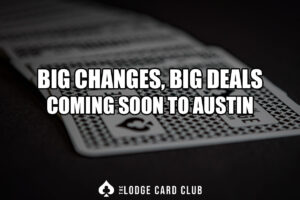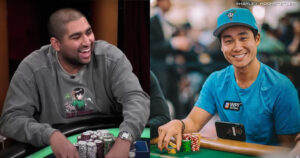Dealer’s Choice is a poker format in which players take turn selecting which game is played. While most poker games involve only one game variant (like No-Limit Hold’em or Pot-Limit Omaha), Dealer’s Choice games can include eight, then, or even 20 or more possible games.
The Lodge runs a $20/$40 Dealer’s Choice cash game every Wednesday afternoon. The nature of Dealer’s Choice requires players to come to the table with a well-versed understanding of the poker strategy of many different poker games.
Let’s take a look at how Dealer’s Choice works, along with some of the poker variants you can expect to see in this mixed game format:
Dealer’s Choice Basic Rules & Procedures
A Dealer’s Choice game allows players to take turn picking the game that’s played. Whatever game a player picks is played for one entire orbit at the table, after which another player picks the game.
A true Dealer’s Choice game allows any player to pick any game when it comes their turn to choose. Structured games and tournaments, like the Dealer’s Choice bracelet event at the World Series of Poker, only allows players to choose from a predetermined list of games.
The WSOP event list includes 20 different games, hardly a limited list by any means. If you sit in on the Dealer’s Choice game at the Lodge, the list of potential games might be even bigger.
Here’s a glance at just a few of the poker variants you can expect to see if you play Dealer’s Choice at the Lodge, as a casino game, as a home poker game, or elsewhere:
Dealer’s Choice Poker Games
No Limit Hold’em
The most popular poker game in the world often shows up in the Dealer’s Choice mix. No-Limit Hold’em is Texas Hold’em played under no-limit betting rules.
Each player is dealt two hole cards face down, and can use those two cards and any combination of five community cards to make the best hand. The community cards are dealt face up, and come in rounds known as the flop, the turn, and the river.
For many poker players, No-Limit Hold’em is the game they’re the most familiar with in the Dealer’s choice mix. Check out our No-Limit Hold’em Guide for a deep dive into the rules of the game.
Limit Hold’em
Limit Hold’em is Texas Hold’em played with limit betting rules. Under that structure, the amount that any player can bet or raise is limited to preset amounts.
For example, in a $20/$40 Limit Hold’em game, the most any player could bet in the first two betting rounds is $40. In the final two betting rounds, that amount increases to $80.
The number of possible bets and raises in a given round is four. For instance, in the preflop and flop rounds, the first player to act could bet $40. Another player could raise to $80, another to $120, and another to $160.
After the active bet hits $160, other players can only call. Texas Hold’em played under limit betting rules plays quite differently than No-Limit Hold’em.
Pot-Limit Omaha
Pot-Limit Omaha (aka PLO) plays as one of the most popular games among Lodge regulars. Texas Hold’em, PLO is a community card board game.
Each player in a PLO game gets four hole cards. You must exactly two hole cards and three community cards to ake the best possible five-card hand, according to standard poker hand rankings.
The requirement to use two hole cards and three community cards makes Omaha different from Texas Hold’em. Inexperiecned players can often fall into the trap of thinking they can use any combination of hole cards and board cards, as with Hold’em.
Check out the Lodge guide to Pot-Limit Omaha for an expanded look at PLO.
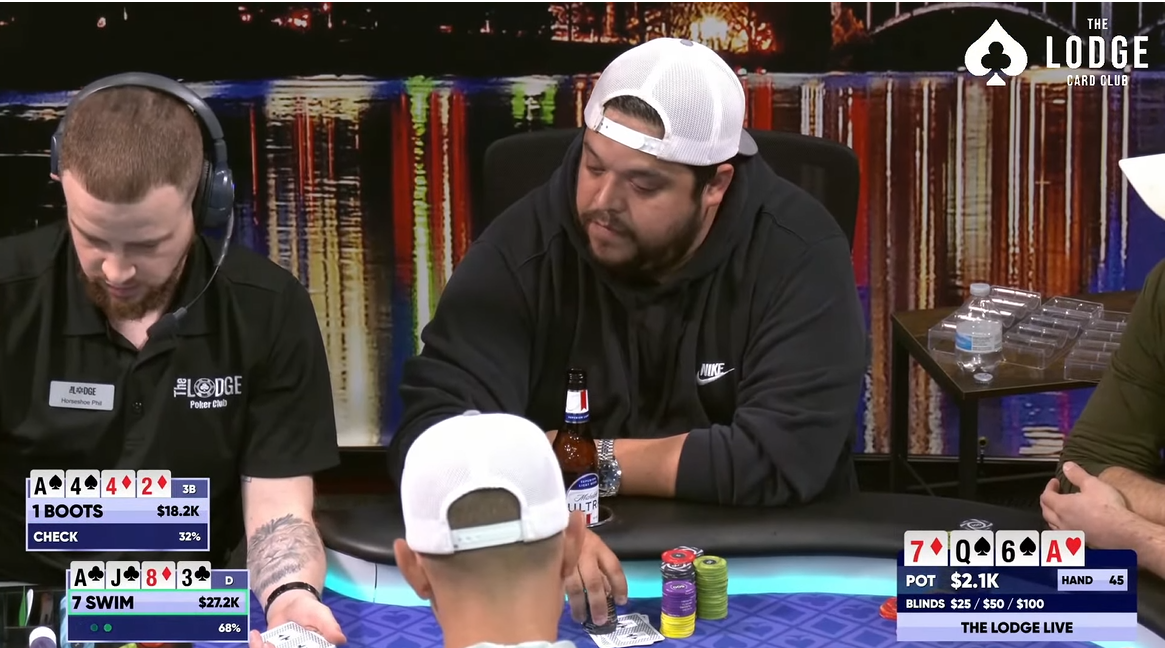
Omaha Hi-Lo
Omana Hi-Lo (aka Omaha 8 or Omaha Eight or Better) is the Omaha poker variant played with split-pot betting rules. Card games with a split-pot structure award half of the pot to the best high hand, and half of the pot to the best qualifying low hand.
The high-hand portion of the pot goes to the hand that would normally win under standard poker hand rankings.
The low-hand portion of the pot goes to the lowest-ranking five-card hand, but only if that hand’s highest card is no higher than an eight. Eight-high or lower hands that meet the criteria to take the low portion of the pot are known as qualifying low hands.
In Omaha Hi-Lo, straights and flushes don’t count against the qualifying low. Pairs, three-of-a-kind, four-of-a-kind, and full houses do count against the qualifying low, however.
For example, 5-4-3-2-A is the best qualifying low hand possible in Omaha Hi-Lo. The fact that this hand makes an ace-to-five straight doesn’t count against its status as a qualifying low hand.
A hand like 5-5-3-2-A, however, doesn’t qualify for the low, as the pair of fives disqualifies it.
With four hole cards per player, it’s possible to use different combinations of hole cards to make both the best high and low hand in the same pot.
Omaha Hi-Lo is generally played under fixed-limit or pot-limit betting rules.
Dramaha
Dramaha poker is a mix of Pot-Limit Omaha and Five Card Draw. Each player gets five hole cards to begin a round, and an initial betting round commences.
After that, the dealer puts down three community cards (aka the flop). A betting round takes place after that, much like a game of PLO.
When the flop betting round ends, however, a drawing round takes place. All players still in the hand can discard any number of hole cards, getting new cards from the deck much like the other draw poker games on this list.
The hand plays out with turn and river betting rounds. The game then awards the pot in split-pot format, with the player holding the best PLO hand getting half of the pot, and the player with the best five-card draw hand winning the other half.
Listen to Doug Polk explain some of the various ways to play Dramaha in this clip.
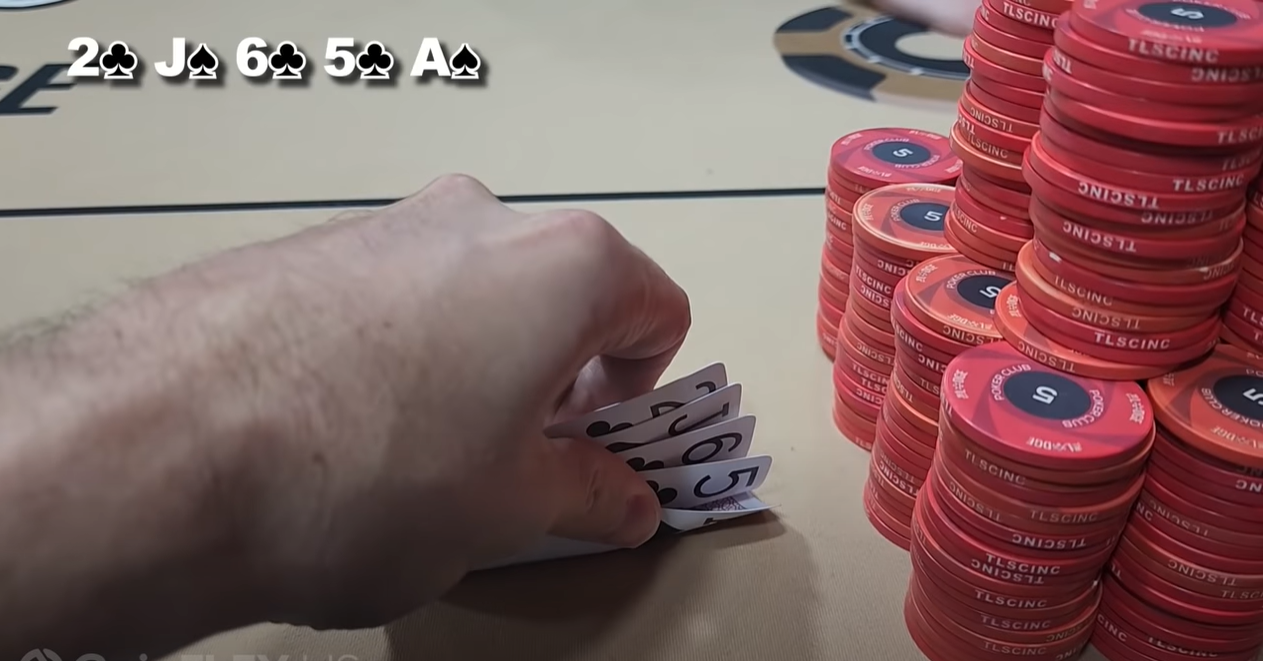
Big-O
Big-O is one of the most popular poker variants played at the Lodge. You’ll find Big-O games regularly at the center of poker tournaments and cash games at the club.
You can also expect to see Big-O played as part of the Dealer’s Choice mix. Big-O is Omama Hi-Lo played with five hole cards and pot-limit betting rules.
With five hole cars per player, the possibility of seeing very strong hands goes way up. Keep in mind that like all Omaha variants, Big-O requires that you use exactly two hole cards and three board cards to make the best high or qualifying low hand.
Check out the Lodge’s guide to Big-O for a deeper look into the five-card Omaha variant.
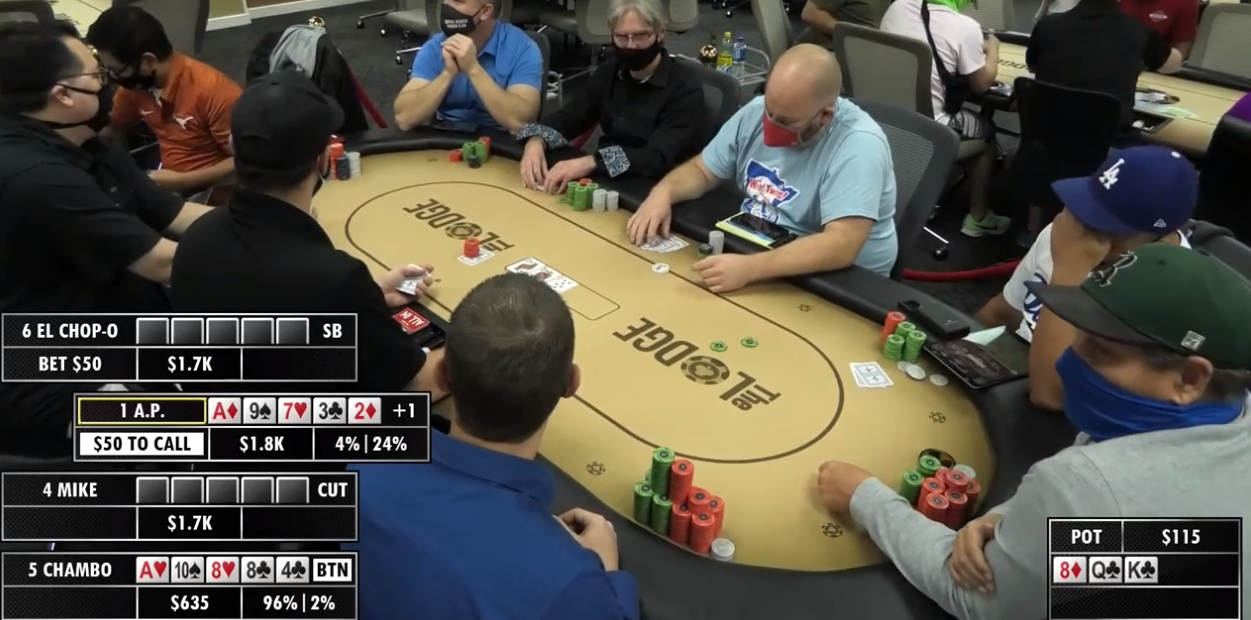
Seven Card Stud
Seven Cards Stud poker is one of the oldest variants of the game. Unlike Hold’em and Omaha, there are no community cards dealt in Stud games.
In Seven Card Stud, each player is dealt their own hand of up to seven cards. Each round beings with each player dealt three cards; two face-down hole cards and one face-up card. The face-up card is known as the door card.
Stud games don’t play with a button and blinds system like some of the other games on our Dealer’s Choice list. Each player puts in an ante before the hand, and the rest of each round plays under fixed-limit betting rules.
After each betting round, another card is dealt. If you stay in the pot through the end of the hand, you end up with seven cards dealt. Your hand will consist of the first two face-down hole cards, four upcards, and another face-down card dealt as your seventh and last card.
The object of Seven Card Stud is to make the best possible five-card high hand according to standard poker hand rankings.
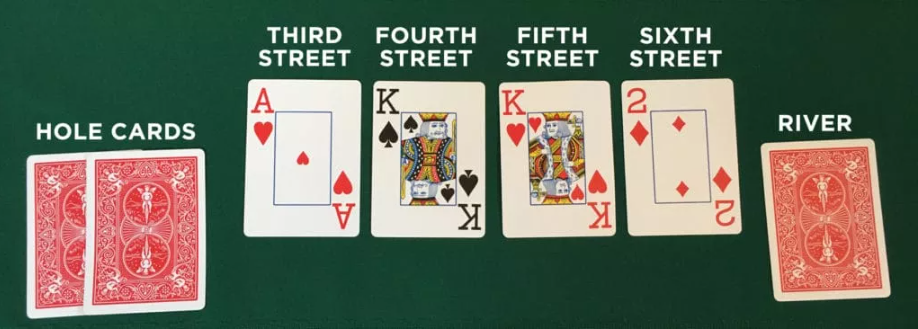
Seven Card Stud Hi-Lo
Seven Card Stud Hi-Lo (aka Seven Card Stud 8) is Seven Card Stud played under hi-lo betting rules. Much like Omaha Hi-Lo, each pot is split between the best five-card high hand and the best qualifying low.
You can use your seven-card hand to make both the best high and low hand. If you win both, you scoop the pot, taking the entire amount of money in the middle.
Straights and flushes don’t count against the qualifying low. Stud Hi-Lo is played with fixed-limit betting rules.
Razz
Razz plays like Seven Card Stud, but the object is to make the best possible five-card low hand. Unlike split-pot games, you don’t have to make an 8-or-better low to qualify for the pot in Razz.
For example, a hand like J-9-5-4-3 could win the pot in Razz, while that isn’t possible in other hi-lo games.
Flushes and straights don’t count against low hands in Razz, but pairs, three-of-a-kind, four-of-a-kind, and full houses do. A hand like J-J-5-4-3, for instance (with a pair of jacks), would lose to a hand like Q-T-7-6-5 (queen-high).
Like almost all Stud games, Razz is played with a fixed-limit betting structure.
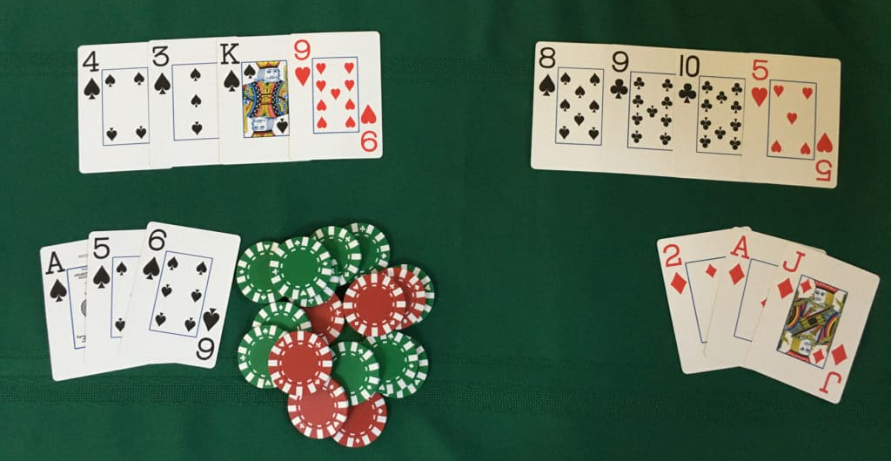
2-7 Lowball Triple Draw
The game of 2-7 Lowball Triple Draw (also styled as “Deuce-to-Seven Lowball) falls under the category of draw poker.
The object of the game is to make the best possible five-card low hand, but under deuce-to-seven rules. That means straights and flushes do count against the low, and the best possible low is 7-5-4-3-2.
Each player starts with five cards, all face-down. After an initial betting round, all players still in the hand can choose t discard as many cards as they like, and replace them with cards from the deck.
This process of a betting round followed by a draw is repeated two more times. At the end of the third and final draw, one more betting round takes place.
At the end of all betting rounds and draws, the player with the best low-card hand (under deuce-to-seven rules) wins.
This game is generally played with a limit betting structure.
No-Limit 2-7 Lowball Single Draw
Like 2-7 Lowball Triple Draw, No-Limit 2-7 Lowball Single Draw is a five-card draw game in which the object is to make the best low hand under 2-7 rules.
Unlike its Triple Draw counterpart, however, there’s only one drawing round per pot. After all players are dealt five face-down cards, the first betting round takes place.
After that, the first and only drawing round commences. After that draw, the second and final betting round takes place.
The winner is the player who holds the best five-card low hand under deuce-to-seven rules. No-Limit 2-7 Lowball Single Draw, as the name suggests, is played under No-Limit betting rules.
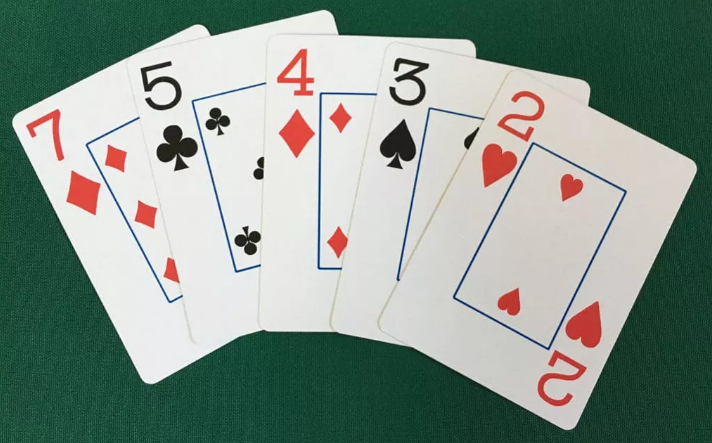
Badugi
Badugi is a draw poker game that plays similar to Lowball Triple Draw, but with a few significant differences.
Each player in a game of Badugi gets four hole cards. Like other Triple Draw games, each hand involves an initial betting round, followed by three drawing round and three betting rounds.
The highest-ranking hands in the game are called “four-card badugis,” which consist of four cards of different suits with no pairs. For example, the best possible hand in Badugi is A-2-3-4 of all different suits.
When your hand has two or more cards of the same suit, or two or more paired cards, it can’t qualify as a four-card Badugi. A hand like A-5-6-6 or A-8-9-T with two hearts would count as a three-card badugi. All four-card badugis beat three-card badugis, three-card badugis beat two-card badugis, and so on.
You’ll often see Badugi in the dealer’s choice mix, as well as variations like Badacey, Baducey, and others.
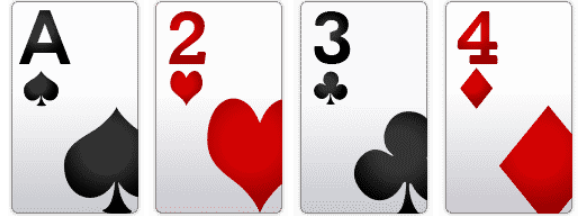
Check out the following guide from Upswing Poker for tips and strategies on five of the core games that you’ll find in almost any dealer’s choice mix:
Perfect Limit HoldEm and Omaha 8 Strategy – Beating a Dead HORSE Part 1

